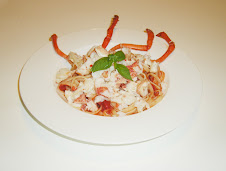I can’t begin to imagine a world without the scent of vanilla. It would be like Spring without flowers or rain with no hope of eventual sunshine and the smell of fresh grass.
Where would peach pie, cupcakes, pudding and angel cake be without vanilla - that sensual aromatic that lures us into sugar consumption? If you have ever smelled crystallized sugar, you have noticed that by itself, it has very little scent. The alchemy of combined sugar and vanilla emerges via the baking process. Exposed to heat, these two elements exude the seductive scent of carmelization, enveloped in an irresistible floral perfume. Can we really be sure that it was the apple that tempted Adam and Eve?
As I have journeyed through this culinary world, I have noticed that with increased frequency, many of our foods are lacking in flavor. A combination of factors have played a role in this, the most prominent one being factory farming. It saddens me even more to realize that our children may be denied the precious experience of savoring the true flavors of real food. For example, my favorite variety of corn, “Silver Queen,” no longer exists, according to the Slow Food organization. Yet, its distinctive flavor continues to linger in my taste memory. Another of my vivid taste memories is of lobster in Bar Harbor, Maine, picked up amongst the seaweed washed ashore from a broken trap after a winter storm. In contrast to that vivid memory, there is hardly a shadow of such flavor in lifeless lobster that comes to us from a supermarket tank. I search in vain for the flavor and texture of a crisp McIntosh apple pulled right off the branch; or a Kathadan potato roasted in a wood fire. And now I worry about my beloved vanilla, the aromatic pleasure that floats out of a plump oily black Tahitian vanilla bean…ah, so fresh and happy in its perfume. But let me move on, for such talk is causing me to feel depressed.
Occasionally, I will explore local “trendy” bakeshops to taste what the bakers are producing. I often ask what type of vanilla is being used in the baking process. More often than not, I am shocked to learn that the baker has simply gone with the cheapest vanilla available. It saddens me that many bakers put cost ahead of quality.
I always try to obtain the very best ingredients for my baking projects. Regardless of a baker’s skill and talent, the end result will only be as good as the ingredients that are used. And, given the alchemy that takes place when vanilla and sugar merge together, why would anyone want to skimp on the vanilla? I am constantly reminded of the prescient words of Alan Watts, who warned us in his chapter, “Murder in the Kitchen,” that the integrity of our food ingredients was in danger – and that was some forty years ago!
As a private chef, I sometimes have had to struggle with clients, who balk at the cost of certain ingredients. The process of becoming blasé about flavor is an insidious one. Over time, our collective taste buds have become increasingly accustomed to flavorless cardboard that giant food factories manufacture. And when we can no longer appreciate the difference, cost has succeeded in a leverage buy-out of our taste sensation.
I suspect that few people know that vanilla was almost wiped off the face of the earth, due to a blight that was not unlike the phylloxera scare of 19th France, which almost wiped out Bordeaux’s wine grapes. In the case of vanilla, it appears to have been over-production (caused by factory-style farming) that almost caused its demise. The orchid seeds were planted too close together, creating an opportunity for a voracious fungus that destroyed nearly eighty percent of the Vanilla crops in Madagascar.
We can only hope that this blight has been successfully eradicated, because it is hard to imagine a world without vanilla.
To obtain the very highest quality vanilla – from a socially conscious and highly knowledgeable purveyor - visit the website of Patricia Rain (the “Vanilla Queen”): www.vanilla.com. Patricia Rain is THE authority on vanilla. At her website, you will find the finest vanilla available, as well as an excellent repository of trusted information.



